The number of living fish species is over 26,400 which is 51.9% of almost all vertebrates. Like other vertebrates, fish have an unequal abundance and diversity. Their ancestors were widespread 500 million years ago. They spread through a massive time-wide evolution and had the opportunity to originate and become extinct in major phyletic streams, even as modern bony fish or teleostians originated 250 million years ago when most groups of fish were firmly established. Despite repeated and uninterrupted research, the relationship between evolution and fish is still highly debated. All fossils and living fish belong to the Agnathans or Gnathostoms. However, the independent evolution of each of these fundamentally different groups has become clear. The phylogeny of fishes as a whole can only be reorganized in its widest range. There are many groups of jawless and jawed fish that have become extinct due to their failure to survive geologically. Paleozoic heterostracans and thelodont are the most ancient jawless fish. These are the first vertebrates mentioned in the fossil record. These and other Paleozoic aganathans are collectively called Ostracoderms (Romer 1966).
You might also read: Feeding Adaptation of Fishes
By examining the structure and internal characteristics of different groups of fish, considerable evolutionary and ethnographic similarities can be found between them. Jaymoytius, found in the Silurian cliffs of England, is considered to be representative of the oldest Chordates. They have V-shaped myotomes and uninterrupted middle and lateral fin folds. It is further speculated that skull-bearing animals evolved from ancesters resembling Jaymoytius. Some of the scattered fossils of Ostracoderms found in the rock formations in the Middle Ordovician period about 500 million years ago are considered primitive fish. In the Silurian era, jawless fish or agnatha and primitive jawed fish or gnathostomata were well established.
Phylogeny
The evolutionary history of an organism or a taxonomic group is called phylogeny. The word phylogeny is derived from two Greek words ‘phylon’ meaning race or tribe and ‘genia’ meaning origin. According to R.D. Barnes –‘Phylogeny is the evolutionary history of a group of animals’.
Phylogeny of Jawless Fishes/Agnatha
Fossil records provide evidence of the first appearance of fish in the Palaeozoic Era during the Ordovician period, about 500 million years ago. The Devonian era is called the fish era because of the abundance of fish. According to fossil records, ancient primitive jawless vertebrates were found at the Ordovician rock level who lived in the Devonian period. These small fish-like creatures were able to live and swim in freshwater. These are collectively called Ostracoderms.
Ostracoderm developed in the Ordovician, Silurian, and Devonian eras. They belong to the class Ostracodermi. Their characteristics features are mentioned below:
1.The body was dorso-ventrally flattened with a heavily armored head.
2.These were relatively small in size. The length ranged from a few centimeters to 18 centimeters.
- The large head had a gill chambers.
- Paired eyes and a single nostril existed.
- They had jawless sucking type mouth.
- There were no axial skeletons.
- The scales and bones were well formed.
- The paired eyes were located at the top of the head.
The surviving cyclostome originated from a jawless, heavily armored, and bottom dwelling jawless Ostracoderm, whose body was covered by a dorso-ventrally compressed, wingless, bony shell. These jawless heavy armored ostracoderms flourished in the last Silurian and Devonian eras. They are thought to be related to cyclastomes because of their similarity to the brain, ears and blood vessels. Most of their bodies were armored and rarely had a reduced bone marrow. This bony coating helped to protect against the Silurian-era giant scorpion-like Eurypterids, as well as preventing the exchange of permeable fluids between body fluids and environmental fluids.
Ostracoderms can be divided into three main orders, namely: Pteraspida, Cephalaspida and Anaspida. Of these, Pteraspida existed in the more ancient and Ordovician eras. Cephalaspids and anaspides were alive in the Upper Silurian era. However, all Ostracoderms became extinct during the Carboniferous period. However, the relationship between the different orders is not clear. Extensive research by Erik Stensio (1920) has revealed the relationship between cephalaspids and the current Lamprey (Petromyzon) and hagfish (Myxine). According to him, lamprey and hagfish were derived from pteraspids. A third evolutionary theory states that they are thought to have originated from Thelodonts. Only one of these fossils has been found. According to another view, placoderm is also believed to have originated from ostracoderm through the development of jaw, paired fins and other such features.
The oldest living vertebrate is the cephalaspidomorph cyclostome. They evolved from armored Agnatha. Moreover, the absence of jaws, slippery and elongated structure has helped them to adapt to receive parasites or scavengers as food. Their appendages do not have fins and legs, but at present (rarely) all types of modern fish have paired appendages. Moreover, their actual cartilaginous skeleton has helped to form the original features. However, their bone-like tissue or cartilage is both primitive type (Moss, 1974).
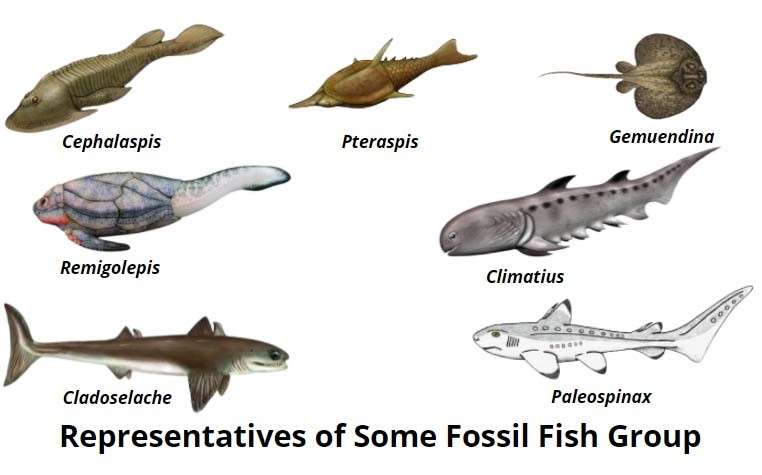
Living lampreys and hagfish together are called cyclostomes (Cyclos = round, + Stroma = mouth). The cyclostome represents the primitive living craniates. Many researchers have classified them as structurally inferior to fish and superior to Branchiostoma. Cyclostomes are considered to be more ancient than Gnathostomes. However, according to Erik Stensio (198) and Erik Jarvik (198), the gnathostome is older than the cyclostome. The lamprey carries better features than the hagfish; For example: (1) The middle fins of a lamprey are divided into two parts but the fins are uninterrupted in a hagfish; (2) The two nostrils in the lamprey are located in the mid-dorsal region, but in the hagfish they are marginal; (3) There are two semicircular ducts in the inner ear of the lamprey but the hagfish contains semicircular ducts in the inner ear; (4) In lamprey, paired eyes are active but in hagfish, there are no roles of eyes; (5) Suckers are less developed in hagfish than lampreys; (6) Hagfish have functional pronephros but absent in lamprey; (7) The lamprey contains poorly developed vertebral material but it is absent in the hagfish; (8) The skull is well developed in lamprey than hagfish.
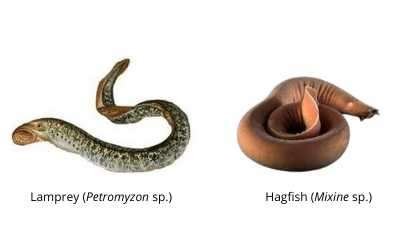
Phylogeny of Jawed Fishes
The jawed fish can be divided into two groups according to the evolutionary trend, namely- (1) Placoderms and (2) Living Jawed Fishes. Living jawed fish are further divided into two main groups, namely (a) Chondrichthyes and (b) Osteichthyes.
Phylogeny of Placoderms
The primitive jaw-bearing fish formed the basis of the gnathostamata and from which the tetrapods originated. The location of placoderms near the base of the Elasmobranchiomorphi in the mainstream of the evolutionary history of bony fish. Fossils of Placoderm have been found in the last Silurians and they prospered in the Devodian era, known as the fish age and became extinct in the Carboniferous era. Thus their history is limited to the Paleozoic era (Moy-Thomas and Miles 1971). They had common skeletal bones and paired fins.
Placoderms are the oldest vertebrates with jaws that lived in the Silurian era and dominated for a short time in the Devoidian era. However, they all became extinct towards the end of the Permian period. They are sometimes called Paleozoic fish because they lived in Paleozoic era. The bodies of these fish were called placoderms because their bodies were covered with heavy bone plates. By the time they were alive, they had adapted to different ways of life and had become a disparate group. Some important their features are described below:
- Each of them had the primitive type of jaw. Their strong upper jaw was combined with the skull.
- Unlike modern fish, they did not have hyoid arches in their jaws.
- Hyoid gill openings existed but spiracles were not formed.
- The paired fins existed but they were different in different members of the same group. 5. They ranged in length from a few centimeters to 3 meters or more, up to 10 meters (Dunkleosteus).
- They had heterocercal tail.
Placoderm can be divided into three classes:
Class-1: Acanthodii
Class-2: Coccostei (Arthrodira)
Class-3: Pterichthyes(Antiarchi)
Class-1: Acanthodii
Acanthodians are the earliest placoderms. These fishes continued until the Permian era. The placoderm had the primitive jaw which was not as efficient as the later gnathostomes. Externally it was similar to sharks. They had characteristic spines on all fins except the heterocercal caudal fins. The body is covered with small, flattened bony scales and, like all other placoderms, the cephalic and thoracic bony shield did not develop. These fish had a combination of primitive and specialized characteristics and were related to the ancestors of bony fish. Acanthodes bronni and primitive bony fish (Osteichthyes) have basic similarities to the skull but no resemblance to Chondrichthyes (Miles 1974). At the same time Placoderms existed as Acanthodians. One of these genus survived until the Carboniferous era. The rest became extinct around 300 million years ago, around the time of the Devonian era.
Class-2: Coccostei (Arthrodira)
Arthrodires are also called armored fish with articulated neck. These were the largest placoderm group of the Devonian vertebrates. The head and gill regions were covered by the anterior or scalp shield of the body and most of the trunk was covered by the thoracic shield. The rear shield was connected to the front shield by ball and socket joints. As a result, they were able to move their heads freely up and down the trunk for the first time. Moreover, their compressed bodies are reminiscent of the habits of the bottom dwelling. These fish were up to 5-10 meters in length. Their odd jaw plates were not like the jaws of higher vertebrate. Since the hindlimbs of their bodies were not usually covered by armor, the movement of fish was greatly improved.
Class-3: Pterichthyes (Antiarchi)
Antiarchs (Antiarchi) were small fish with abnormally paired bony appendages, without spines and fins, up to 30 cm long. These fish were widespread during the Devonian period. Their basic structure is similar to that of the Arthrodires but they have slender, crooked jaws, abnormal and freely moving pectoral fins. The pectoral fins are thought to have originated from the fixed spines of fish of the previous two groups (Arthrodires and Acanthodians). These fins helped to keep oneself attached to any object in the river.
Phylogeny of Chondrichthyes
The cartilaginous fish originated from some of the ancestors of some placoderms. These include different types of sharks, Rays and Chimaera. They appeared in the Middle Devonian era and soon became well-established and existed until the present era. The mainstream evolution of sharks is thought to have taken place in the marine environment. Cartilaginous fish are mainly marine and have flexible skeletons. They have no primtive stage. Sharks are thought to be more primitive than bony fish, but they appear after the first bony fish. However they carry lower organizational structure.
Cladoselache is a type of primitive shark that lived in the Upper Devonian period. They had a typical shark-like body, heterocercal tail, two pectoral and pelvic fins. The pectoral fins are very large and are formed by the simple extension of the body wall. Their skulls were of the amphistylic type. From such an ancient acestor lineage, cartilaginous fish have evolved in different ways. Of these, the Pleuracanth shark is the most ancient, appearing in the Carboniferous period. Like the cladoselachians, they also had amphistylic types of jaw braces, but in some respects they are special. They had shark-shaped bodies with diphycercal caudal fins and a long dorsal fins. The paired fins were of the archipterygian type and a long spine pointed from the skull which was pointed backwards. Paleospinax is the oldest fossil shark among modern sharks.
In the Mesozoic Era, the skull of the pioneer shark has changed and become more hypostylic, making the jaw more independent of movement. Mesozoic sharks originated from these. Sharks are active, fast swimmers and predators. They have torpedo-shaped bodies, strong heterocercal tails, and paired fins with slender bases. Skates and rays have evolved into other genres. They have acquired the specialty of living on the bottom. The pectoral fins of all these fish are very elongated, the tail is narrow and whip-shaped and the gill openings exist in the ventral side.
Some genera, such as Heterodontus, Hexanchus & Chlamydoselache, occupy a position between Chlamydoselachians (Chlamydoselachus) and modern sharks. This is why they are called living fossils. Holocephali is a specialized group of cartilaginous fish. These include chimerids, who live in the deep sea. Their skeletons are made of cartilage, the gill openings are covered by operculum. Fossil records show that the group that emerged as the pioneers of the Carboniferous era, the Iniopterygii, was later referred to as the Holocephali (Zangerl 1974) and has a primitive Elasmobranch link to their dentition. Roughly speaking, cartilaginous fish is a successful group among vertebrates.
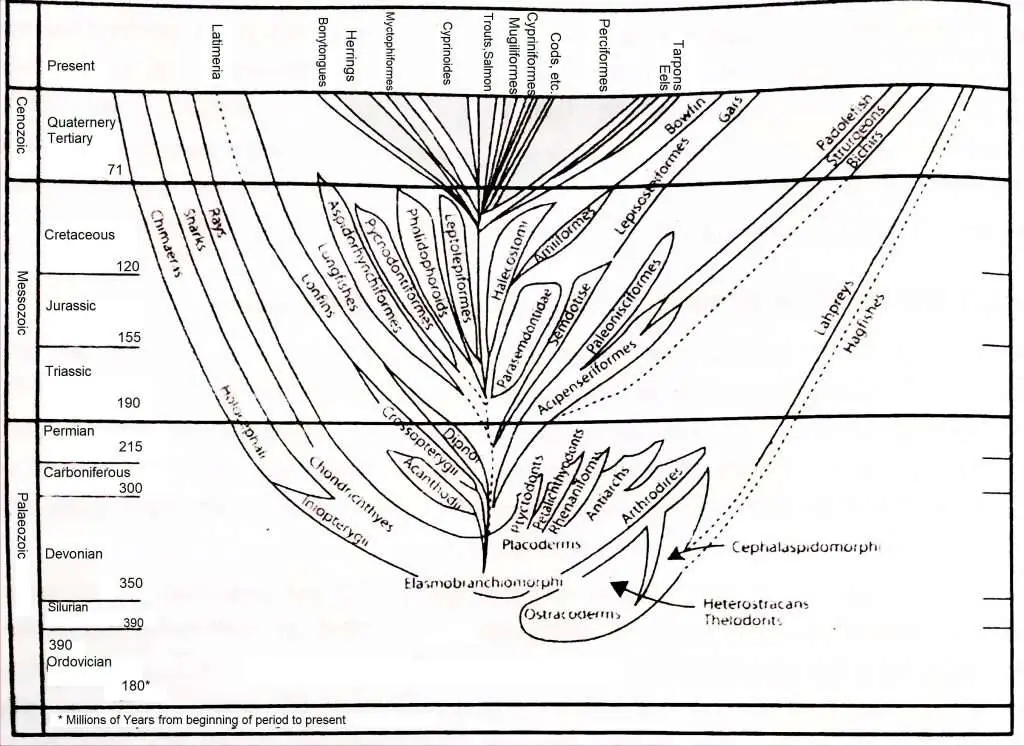
Phylogeny of Osteichthyes
The bony fish appeared independently with the Elasmobranch in the Middle Devonian era. However, the four main groups of bony fish have existed since the Devonian period. Some researchers believe that bony fish originated in the Ordovician period, probably more than 400 million years ago. These fish have operculum, bony skeletons and swimbladders for living in low oxygenated water. Bony fish can be divided into 4 main groups, namely: (1) Dipnoi or Lungfish, (2) Crossopterygii or Lobed Fin fish, (3) Brachiopterygii or Bichir fish and (4) Actinopterygii or ray fined fish. Romer (1966) included the 1st and 2nd groups in the Sarcopterygii subclass and the 3rd and 4th groups in the Actinopterygii subclass. But Nelson (1969) placed Brachyoptergii in the category of Chondrostei-grade order Polypteryformes under Actinopterygii.
Dipnoi or Lungfish
They existed from Lower Devonian to modern times. At present there are 6 species belonging to 3 genera under 2 families. There are 35 extinct genera under 9 families. The fossils found in the Devonian period are Dipterus. They have carrot-shaped bodies, with heterocercal tails. They have acquired some specialty in the fins, scales and skull bones. However, they gradually evolved into the Lower Devonian era. At present, three of them are still alive. The three genera are Protopterus, Lepidosiren and Neoceratodus, which usually live in rivers but can also live in arid environments (mud).
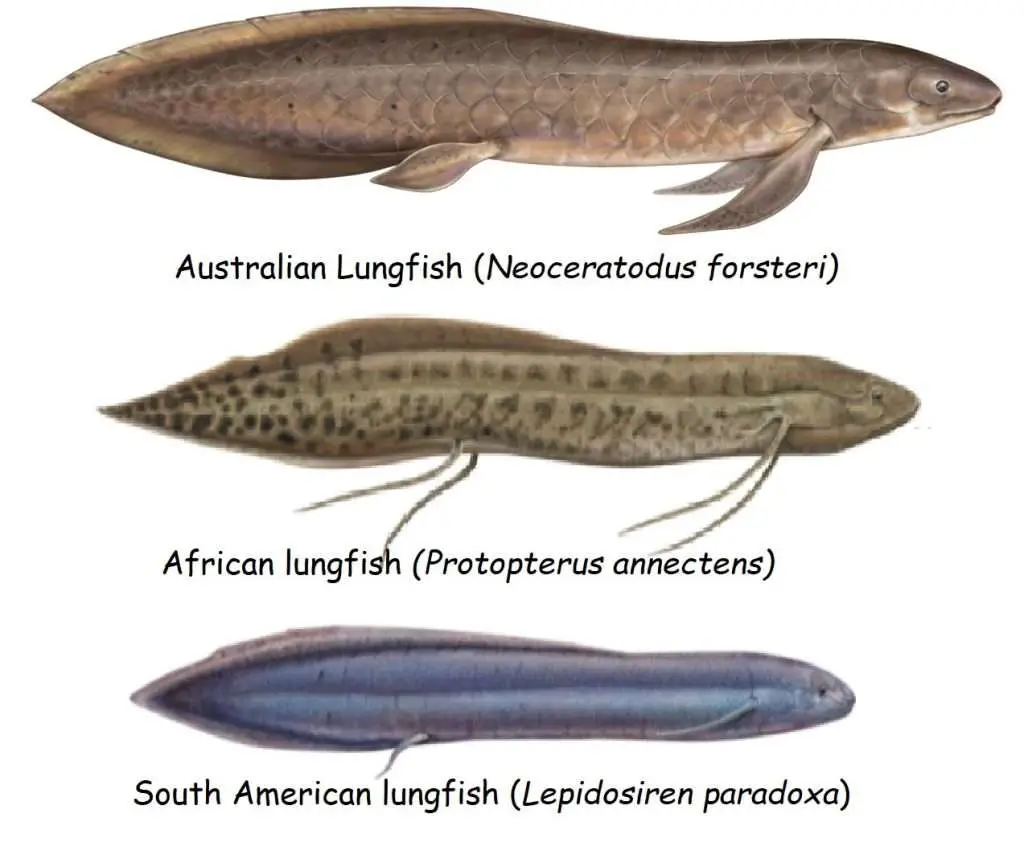
Crossopterygii or Lobed Fin Fish
They range from Lower Devonian to modern times. They have 55 extinct genera and only one living species (Latimeria chalumnae, knownsin 1838). Their fossil record is Osteolepis, which makes a close resemblance to Dipterus. They had carrot-shaped fusiform bodies, strong heterocircal tails, lobate archipterygeal fins and heavy cosmoid scales. They had ossifed skull and nostrils. From this it can be said without doubt that Dipterus and Osteolepis have the same independent ancestor. Therefore, it can be said that Dipnoi and Crossopterygii are descended from the same common ancestor. Two branches have originated from the primitive Crosopterigians, one suborder, Rhipidistia (Osteolepidoti) and the other Coelocanthinii. The Devonian genus of Rhipidistians probably originated directly from Eusthenopteron. This is how tetrapods originated from osteolepids.
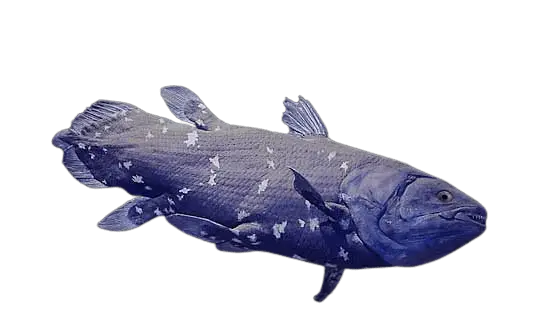
Actinopterygii
The first Actinopterigian belongs to the order Paleoniscoidia. They had heavy rhomboid scales. Their Davodian representative is Chirolepis. The notocord of these primitive small fish was well developed with heterocercal tail and incomplete ossified vertebrae. Subsequent actinopterigians evolved from Chirolepis-like predecessors and went through three stages of development, such as Chondrostei, Holostei, and Teleostei. Polypterus and Callamoichthyes as representatives of Brachiopterygii which originated from Paleoniscoid and confined to tropical Africa. They are called living fossils because of their primitive and special features. These are usually classified as an order of Actinoterygii. However, there are some important similarities with crossopterygii and some differences with standard actinopterygii. That is why some researchers want to place them in separate subclases.
Sturgeon fish (Acipenser) has emerged from Paleoniscoidae. They have spiracles, but no heavy scales. Both Polypterus and Acipenser are chondrostean fish belonging to the Chondrosteii super order. In the Triassic period, some progressive chondrostean fish emerged from the Paleoniscoid ancestors. Notable among these fish is Redfieldia. The upper lobe of the heterocercal tail of these fish is reduced, the heavy scales are reduced and the jaw is shortened. These fish are considered to be in the stage between chondrostean and holostean fish.
Towards the end of the Triassic, the primitive Chondrostians became more specialized than their predecessors and were gradually replaced by the Holosteans. In this case, the upper lobe of their heterocercal tail is reduced again and the spiral is extinct and the skull and jaw have acquired special characteristics.
The Holosteans currently have two genera, Amia and Lepidosteus. Both have vascular lungs for respiration. Holosteans have been gradually replaced by teleosts. The first teleost to exist in the Jurassic period was Leptolepis. These are the stages between Holostian and Telostian fish. The scaly ganoid layer of the teleost is lost and thin and transparent, the caudal fin is completely homocercal in type and the vascular lung is ruptured. With the specialization of the skull, the internal skeletan has become ossified. Teleosteans have been well-established since the Cretaceous and have evolved into numerous adaptive varieties. The teleosts that returned from the sea became freshwater inhabitants. Among the fish there are numerous successful groups of teleosts. The most diverse teleost group consists of 30,000-40,000 living species. The teleostean type of fish was first seen in the fossil record of the Middle Triassic era. In some cases, however, the transition from the Holostean to the Teleostean began long ago.
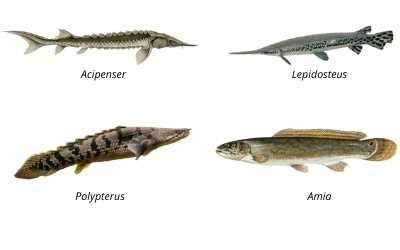
In the modern taxonomy supported by Greenwood et. al., teleostean fish are divided into three distinct categories. Under this, teleosts have been re-divided into 8 suborders. Each of these three divisions has evolved from a distinct ethnic lineage to one of the Holostean organization dimensions. The first section of this classification includes eel and eel-like members such as the herring fish (Clupea harengus). The idea is that they evolved to be a primitive Elopiform ancestors. The second category includes two freshwater fish orders, Osteoglossiformes and Mormyriformes, which are unusually specialized and predominant. The remaining living teleostei fish are located in the third category. They have been irradiated in more than one organizational level and have become a dominant group in freshwater and marine environments.
Lagler (1977) classified Chondrostei, Holostei and Teleostei as superorders in the Actinopterygii subclass. The only Eloipid and Salmonid among the various living primitive groups of teleosteans have acquired the morphological properties suitable for the basis of the main teleostean radiation. Other primitive groups such as Clupiformes and Osteoglosssiformes have also gained prominence for their role. Elopids and salmonids are thought to have evolved polyphyletically from the pre-holostean ancestors or monophylatically from a single Holostean. The potential evolutionary relationship between the major teleostean fish groups has been shown through the following Figure:
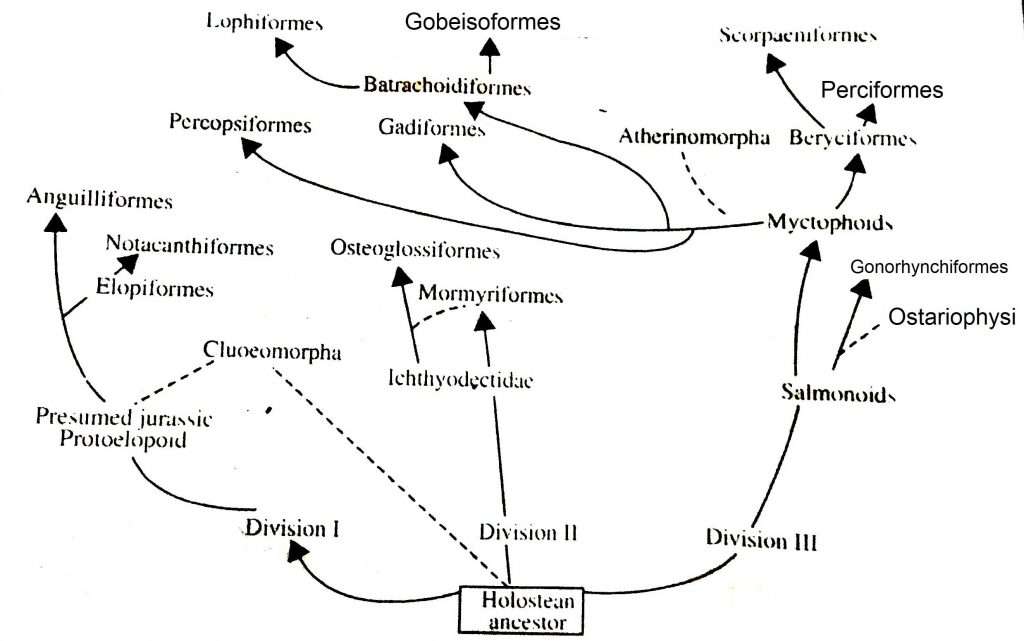
Evolutionary relationships between major teleostean fish groups (After Greenwood et al.)
Some Ichhthyologists have tried to divide the Teleostei into Malacopterygii or soft ray spiny fish and Mesichthyes or the middle group and the Acanthopterygii or strong ray spiny fish. The Malacopterygii section includes most soft-rayed fish. There are many classes of freshwater and salt water, such as Clupeiformes, Cypriniformes, Anguilliformes, etc. Although these fish are bony fish, their bodies are soft and their fins have soft rays without spines. They have cycloid scales and their swimbladders are of the physostomous type.
From the Cretaceous period onwards, the fins of Polypteryformes have existed in the intermediate state of the spiny fins. Perciformes have evolved and spread in different ways from the mainstream of evolution. This category includes numerous freshwater and marine fish. The Seabasses of the family Serranidae have spread worldwide and the freshwater perch of the family Percidae has spread throughout the Northern Hemisphere. The fins of these living fish have spines as well as soft rays. In most cases ctenoid type scales exist. The primaxilla lengthens and forms the mouth gape. If there are pelvic fins, they are in the position of thoracic or jugular. The ideal pelvic fins have a spine and five soft rays. Swimbladder tend to be of the physocylistous type.
You might also read: Lungfish: The Oldest Living Animal On Earth
Questions and Answers
1.What do you mean by phylogeny?
Answers: The evolutionary history of an organism or a taxonomic group is called phylogeny. The word phylogeny is derived from two Greek words ‘phylon’ meaning race or tribe and ‘genia’ meaning origin. According to R.D. Barnes –‘Phylogeny is the evolutionary history of a group of animals’.
2. What is Agnatha?
Answer: Agnatha is a group of primitive jawless fish which belongs to the phylum Chordata. It includes both living (Cyclostomes) and extinct (ostracoderms) fish species. In this case, cyclostomes represent the sister of all jawed vertebrates, called gnathostomes.
3. What is Placoderm?
Answer: Placoderms are the oldest vertebrates with jaws that lived in the Silurian era and dominated for a short time in the Devoidian era. However, they all became extinct towards the end of the Permian period. They are sometimes called Paleozoic fish because they lived in Paleozoic era.
4. What is Ostracoderm?
Answer:
5. What is Actinopterygii?
Answer:
6. What is Crossopterygii?
Answer:
7. What is the lobe fin fish?
Answer:
8. What is Dipnoi?
Answer:
9. What do you mean by chondrostei?
Answer:
10. What do you mean by chondrostei?
Answer:
11. What do you mean by Teleostei?
Answer:
12. What is Cephalaspis?
Answer:
13. What do you mean by Malacopterygii?
Answer:

